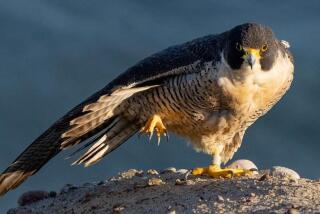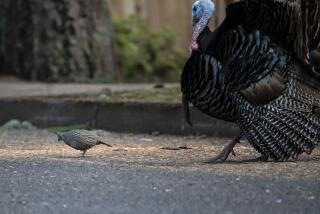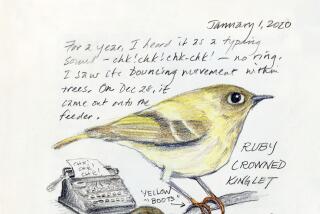BOOK REVIEW : A Born Storyteller Enjoying Her Maiden Flight : WINGS FOR MY FLIGHT; The Peregrine Falcons of Chimney Rock <i> by Marcy Cottrell Houle</i> ; Addison Wesley $17.95, 187 pages
Peregrines have captured the human imagination as few other creatures have done. Scarcely larger than a pigeon, they will unhesitatingly attack a golden eagle. Their speed and ferocity, balanced by their off-duty fidelity and tractability, have for centuries endeared them to falconers. Today, a young peregrine is worth $10,000 in the Mideast, where, author Marcy Cottrell Houle tells us, falconry is the “baseball and football” of the Arabs.
In the United States, the peregrine population is coming back from near extinction caused by the pesticide DDT, which was banned in 1972. In 1975, however, when the then-21-year-old author began the field study this book describes, only a few known peregrine pairs survived west of the Mississippi. The birds had vanished from the Eastern states.
“Wings for My Flight,” Houle’s first book, absorbingly chronicles the author’s four summers observing a family of peregrines on a mountaintop in Colorado.
But “Wings” is also an epiphany. The author, a newly fledged college graduate, discovers that life in the field is less commodious than she could have wished. She learns, too, that country folk aren’t all nice. Not least--as the book’s title suggests--she ultimately experiences a personal transformation.
Along the way, “Wings” treats the reader to some rare sights: “Through my binoculars,” Houle writes, “I saw two peregrines racing at great speed to greet one another. Meeting its mate in a graceful, swirling motion that seemed but one fluid movement, one falcon flipped upside down to grasp something that the other was carrying. The bird then twisted back to Chimney Rock with its bounty while the other returned to circle above me, wailing in displeasure.”
Houle augments her descriptive power with a born storyteller’s gift for yarn-spinning. Like Thoreau in “Walden,” she telescopes events, compressing her four summers at Chimney Rock into one action-packed season. To maintain dramatic tension, she interweaves a counterplot involving the nearby townsfolk.
Much to the author’s devastation, she discovers that these shifty-eyed yokels want to kill the peregrines, not save them. The townspeople see the “tweety-birds” as the sole obstacle to developing the area for tourists.
Tragically, the shooting death of the mother and the subsequent starvation of three of the five chicks nearly ends the happy family life of the peregrines. But the father--after several days of displaying heart-rending grief--stoically assumes the exhausting single parenthood of the two remaining chicks.
Meanwhile, the author, in defending the birds, becomes the focal point of the town’s anger. Attempts to intimidate her, and the intensifying sense of impending doom the incidents engender, reach a climax when she finds her house trailer trashed and all her scientific equipment and camping gear stolen. Chief suspects are the cretinous construction workers who build the trail-side potties near the study site.
The embattled author is defended only by a boon female companion, who shares the trailer with her, and a mysterious, tall, dark and handsome stranger who invariably appears when the author is looking her worst (whom she nevertheless eventually marries--”but that’s another story,” she says).
These leading actors are supported by some Dickensian minor characters. One of them is the eccentric octogenarian Mrs. Fawcett, head of the Fawcett book publishing mega-corporation. The woman appears at the remote study site, thumps her wooden cane on a rock and tells the author, enigmatically, that after living with the peregrines long enough, “You’ll be prepared.”
Mrs. Fawcett’s mysterious pronouncement becomes a kind of riddle for Houle, until the author, in an epiphany, finally realizes its meaning: She must commit herself entirely to the peregrines. “I had made my decision. The study must continue . . . whatever the risks involved. Mrs. Fawcett was right; I was prepared now. The novice scientist at last had fledged, and a stronger, more assured woman had emerged, honed by a mountain and four wild peregrine falcons.”
Self-dramatizing? Of course. Maybe even silly. “Wings” is romantic science--an apparent oxymoron--yet somehow the book succeeds. Although naive and overdrawn at times, this heartfelt tale will bring tears and smiles to even the most stubbornly objective reader.
Next: Jonathan Kirsch reviews “Encounter on the Narrow Ridge: A Life of Martin Buber” by Maurice Friedman (Paragon House).
More to Read
Sign up for our Book Club newsletter
Get the latest news, events and more from the Los Angeles Times Book Club, and help us get L.A. reading and talking.
You may occasionally receive promotional content from the Los Angeles Times.







